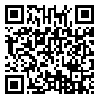BibTeX | RIS | EndNote | Medlars | ProCite | Reference Manager | RefWorks
Send citation to:
URL: http://sjh.umsha.ac.ir/article-1-342-en.html
Introduction & Objective: Tinnitus is one of the most common otologic complaints. This study was designed for evaluation of different kinds of hearing aids effectiveness in treatment of tinnitus in elderly patients in Hamadan.
Materials & Methods: In this clinical trial study 27 referral patients with complaint of tinnitus and hearing loss to otolaryngology clinics in Hamadan during 2006-7 were evaluated. All patients evaluated by PTA, SRT, SDS and Tinnitus matching tests. Persons with more than 40db SNHL and SDS above 60% were referred for hearing aid fitting. In each case behind the ear analogue type of hearing aid were fitted for 3-month course and then it was changed to the digital type for another 3 months. At the end of each course tinnitus evaluation were done and the effect of hearing aids on SDS were reevaluated. Subjective patient satisfaction and the degree of tinnitus diminution were evaluated by designed questionnaire.
Results: From 27 cases17 were female and 10male and the mean of SDS and severity of hearing loss were 77.5% and 60db respectively. Moderately to severe hearing loss (35%) and downward sloping pattern (63%) were the most frequent types of hearing loss and audiogram patterns. Complete recovery of tinnitus were achieved in 55.6% of digital and 33.3% of analogue hearing aids users and the difference between them were significant(p=0.02). Digital and analogue hearing aids performance were satisfactory in 70.4% and 33.3% of the patients respectively and the difference between them were significant too (p< 0,001). Diminution of tinnitus intensity in digital group were more than analogue one (p=0.03) and improvement of SDS before and after fitting of digital hearing aid were better than analogue group) p<0.001). Conclusion: Digital hearing aids can improve communication abilities and subsiding tinnitus in elderly patients.
| Rights and permissions | |
 |
This work is licensed under a Creative Commons Attribution-NonCommercial 4.0 International License. |





